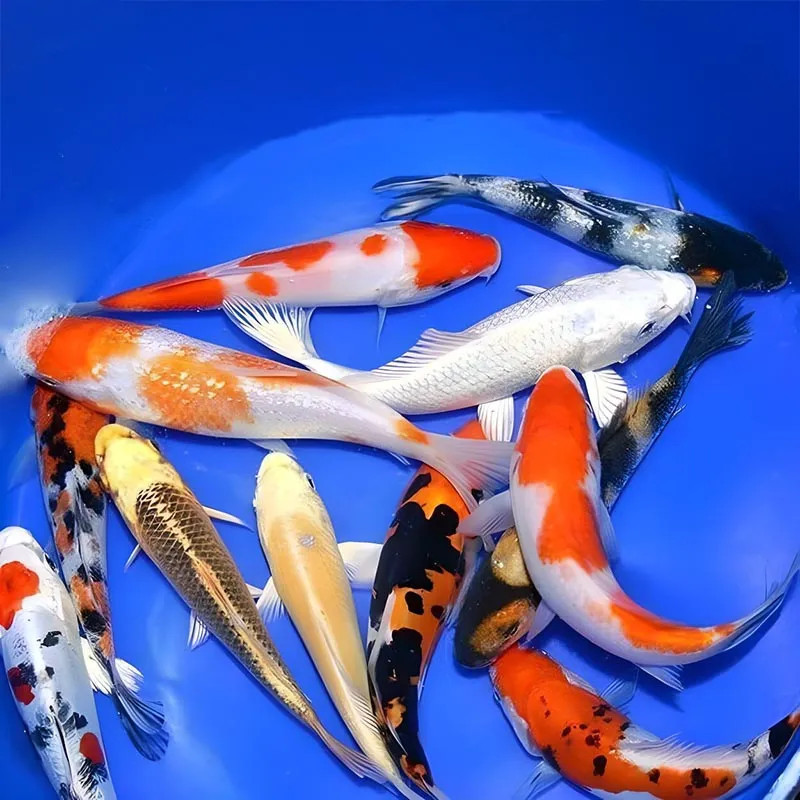Stocks Available
Short body Butterfly koi
SKU:116299
CYPRINUS CARPIO
5-6 INCH

Stock Available
Introduction: • Species: Assorted High-Quality Koi • Common Names: Koi, Nishikigoi, Japan Strain Koi • Natural Habitat: Descended from wild carp, Koi are now bred for ornamental purposes, often found in ponds and water gardens worldwide, originally cultivated in Japan. Physical Characteristics: • Appearance: Comes in a variety of vivid colors and patterns, including red, white, black, yellow, and blue. Markings can include metallic scales, solid colors, or intricate patterns like Kohaku, Showa, and Sanke. • Size: Grows to an average size of 24-36 inches (60-90 cm), depending on genetics and care. • Lifespan: With proper care, Koi can live 25-35 years, with some living even longer in ideal conditions. Habitat Requirements: • Pond Size: Requires a minimum of 1,000 gallons for optimal health and growth. Larger ponds are recommended for a school of Koi. • Water Conditions: o Temperature: Thrives in water temperatures of 59-77°F (15-25°C). o pH: Optimal pH level between 6.8-8.2. • Filtration: A strong filtration system is essential to maintain clean water and support the large bio-load Koi produce. Diet: • Primary Diet: Omnivorous, feeding on aquatic plants, algae, insects, and small invertebrates in the wild. • Supplemental Feeding: In captivity, they are fed high-quality Koi pellets, supplemented with fresh vegetables, fruits, and protein sources like earthworms. • Feeding Frequency: Feed 1-2 times daily during active periods. Reduce feeding during cooler months when their metabolism slows. Compatibility: • Temperament: Peaceful and social, often swimming in groups and interacting well with other Koi. • Suitable Pond Mates: Compatible with other Koi, goldfish, and non-aggressive fish species of similar size. • Incompatibilities: Avoid aggressive or fin-nipping species, as Koi can be stressed by hostile tank mates. Care Level: • Difficulty: Moderate; requires consistent water quality management and a balanced diet for optimal health. • Health Monitoring: Regularly check for signs of disease, such as parasites, bacterial infections, and fungal growth, as well as any changes in behavior or appearance. Breeding: • Breeding in Captivity: Koi can breed naturally in well-maintained ponds during the warmer months. They are egg scatterers, and males chase females, who release eggs that stick to plants or spawning mats. • Spawning: Breeding often occurs in the spring. Provide ample plants or artificial spawning surfaces for eggs to adhere to. Economic Considerations: • Market Demand: High demand for high-quality Koi, especially from Japanese bloodlines, due to their vibrant colors and patterns. • Wholesale Pricing: Prices vary based on size, color, pattern, and lineage, with premium Koi fetching higher prices. • Retail Pricing: Assorted high-quality Koi from Japan are priced according to their uniqueness, size, and beauty, often in the mid to high price range. Sustainability and Conservation: • Wild Population: No wild populations as Koi are bred for ornamental purposes, though they are descendants of wild carp. • Aquaculture Efforts: Extensive breeding in Japan and other countries ensures a steady supply of quality Koi for the ornamental fish trade. • Regulations: No specific conservation concerns, though proper care and responsible breeding practices are encouraged to maintain healthy Koi populations. Conclusion: Assorted High-Quality Koi especially those of Japanese strains, are valued for their stunning array of colors, patterns, and elegance in ornamental ponds. Known for their peaceful nature and longevity, these fish are a popular choice among enthusiasts. With proper care, Koi can thrive in a well-maintained pond, bringing beauty and serenity to any aquatic environment.
Data sheet
5 other products in the same category: